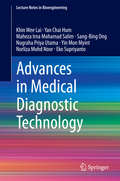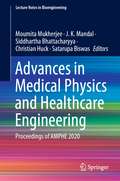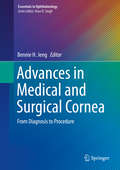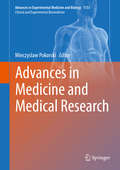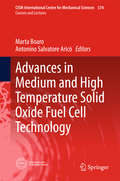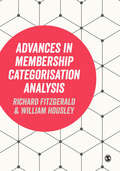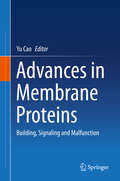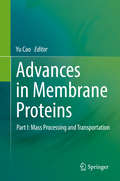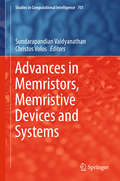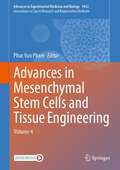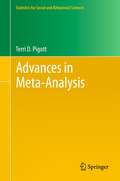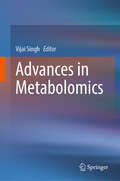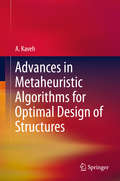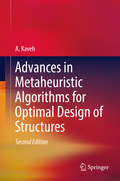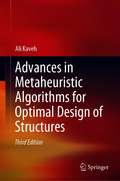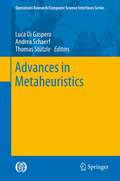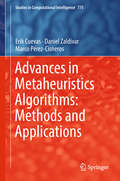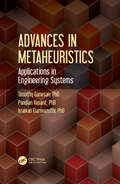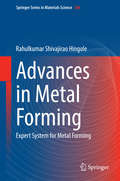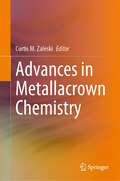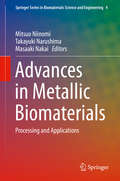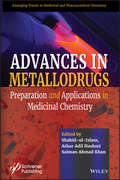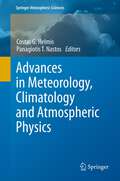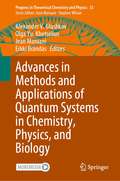- Table View
- List View
Advances in Medical Diagnostic Technology (Lecture Notes in Bioengineering)
by Khin Wee Lai Yan Chai Hum Maheza Irna Mohamad Salim Sang-Bing Ong Nugraha Priya Utama Yin Mon Myint Norliza Mohd Noor Eko SupriyantoThis book provides the most recent findings and knowledge in advanced diagnostics technology, covering a wide spectrum including brain activity analysis, breast and lung cancer detection, echocardiography, computer aided skeletal assessment to mitochondrial biology imaging at the cellular level. The authors explored magneto acoustic approaches and tissue elasticity imaging for the purpose of breast cancer detection. Perspectives in fetal echocardiography from an image processing angle are included. Diagnostic imaging in the field of mitochondrial diseases as well as the use of Computer-Aided System (CAD) are also discussed in the book. This book will be useful for students, lecturers or professional researchers in the field of biomedical sciences and image processing.
Advances in Medical Physics and Healthcare Engineering: Proceedings of AMPHE 2020 (Lecture Notes in Bioengineering)
by Siddhartha Bhattacharyya Moumita Mukherjee J. K. Mandal Christian Huck Satarupa BiswasThis book presents research advances in the theory of medical physics and its application in various sectors of biomedical engineering. It gathers best selected research papers presented at International Conference on Advances in Medical Physics and Healthcare Engineering (AMPHE 2020), organized by the Department of Physics (in collaboration with the School of Engineering and Technology) Adamas University, Kolkata, India. The theme of the book is interdisciplinary in nature; it interests students, researchers and faculty members from biomedical engineering, biotechnology, medical physics, life sciences, material science and also from electrical, electronics and mechanical engineering backgrounds nurturing applications in biomedical domain.
Advances in Medical and Surgical Cornea: From Diagnosis to Procedure (Essentials in Ophthalmology)
by Bennie H. JengThis book presents up-to-date information on the diagnosis and management of the spectrum of medical and surgical corneal diseases, with a special focus on new technology. The latest tools for diagnosing ocular surface disease, infectious keratitis, and ocular allergies are discussed, along with novel treatment options for these entities. The impact of progress in imaging and contact lens technology on the management of corneal conditions is fully described, and the efficacy of corneal collagen crosslinking for keratoconus and corneal ectasia is evaluated. Detailed attention is devoted to the latest surgical techniques, including lamellar keratoplasty, endothelial keratoplasty, keratoprosthesis, and laser-assisted penetrating keratoplasty. In addition, the role of the eye bank in facilitating corneal procedures is explained. Advances in Medical and Surgical Cornea is written by leading authorities who share a passion for effective, cutting-edge care. It will be invaluable for both experienced ophthalmologists and trainees.
Advances in Medicine and Medical Research (Advances in Experimental Medicine and Biology #1133)
by Mieczyslaw PokorskiThis book focuses on issues in clinical practice and research that are of general interest. The articles primarily focus on understanding the pathogenic mechanisms of diseases, their prevention, and therapy. The topics addressed include cardiovascular regulation with regard to blood pressure and heart rate variability, and to coupling blood pressure changes with subarachnoid fluid oscillations. In addition, the book discusses recent advances in the diagnostics of and targeted molecular therapy for renal and pancreatic malignancies, growth disorders, vitamin D and calcium homeostasis in children in the context of neonatal urolithiasis, and neurosurgical interventions in multifarious age-related diseases of the vertebrae. Neuropsychological aspects of patients’ quality of life and of shaping medical staff’s attitude toward patients are also addressed. The respective articles are intended to build a bridge between basic and clinical research. Further, the book enhances the current body of knowledge on diagnostics and patient treatment and offers valuable new perspectives on practical clinical issues. As such, it offers a unique resource for clinicians, family physicians, medical scholars, and professionals engaged in patient management.
Advances in Medium and High Temperature Solid Oxide Fuel Cell Technology (CISM International Centre for Mechanical Sciences #574)
by Marta Boaro Antonino Salvatore AricòIn this book well-known experts highlight cutting-edge research priorities and discuss the state of the art in the field of solid oxide fuel cells giving an update on specific subjects such as protonic conductors, interconnects, electrocatalytic and catalytic processes and modelling approaches. Fundamentals and advances in this field are illustrated to help young researchers address issues in the characterization of materials and in the analysis of processes, not often tackled in scholarly books.
Advances in Membership Categorisation Analysis
by William Housley Dr Richard FitzgeraldThis is an exciting addition to the dynamic, multidisciplinary field of membership categorization analysis. Bringing together the biggest names in MCA this landmark publication provides a contemporary analysis of the field and a platform for emerging researchers and students to build upon. The book sets out the current methodological developments of MCA highlighting its analytic strength – particularly when examining social identity and social knowledge. It provides a sophisticated tool of qualitative analysis and draws from a wide range of empirical studies provided by global scholars. The culmination of years of international research this agenda-setting text will be essential reading for academics and advanced students using membership categorization across the social sciences; particularly in media and communication studies, sociology, psychology, education, political science and linguistics.
Advances in Membership Categorisation Analysis
by William Housley Richard FitzgeraldThis is an exciting addition to the dynamic, multidisciplinary field of membership categorization analysis. Bringing together the biggest names in MCA this landmark publication provides a contemporary analysis of the field and a platform for emerging researchers and students to build upon. The book sets out the current methodological developments of MCA highlighting its analytic strength – particularly when examining social identity and social knowledge. It provides a sophisticated tool of qualitative analysis and draws from a wide range of empirical studies provided by global scholars. The culmination of years of international research this agenda-setting text will be essential reading for academics and advanced students using membership categorization across the social sciences; particularly in media and communication studies, sociology, psychology, education, political science and linguistics.
Advances in Membrane Proteins: Building, Signaling and Malfunction
by Yu CaoThis book reviews recent advances regarding the biochemical and biophysical properties of membrane proteins and their applications in biomedicine. Divided into two thematic parts, this second volume addresses proteins’ formation, signaling and malfunctions. It covers a number of important membrane proteins including receptors, cell adhesion molecules, single-transmembrane proteins and viral membrane proteins, and discusses their structures, functions, related diseases, and roles in drug discovery in detail. In turn, the book elucidates the lifecycle of membrane proteins, including their synthesis and facilitated folding process, as well as QC procedures for their production. Additional topics include fundamental concepts, the latest findings, and critical puzzles yet to be solved. Given its scope, the book will appeal to a broad readership in the field of membrane structural and functional biology. Junior scientists can use it as an introduction to the field, while advanced scientists will find a broader view of the field beyond their area of specialization.
Advances in Membrane Proteins: Part I: Mass Processing and Transportation
by Yu CaoThe book summarizes advances in biochemical and biophysical property of membrane proteins as well as their applications in biomedicine. It is organised into 2 themed parts. This part focuses on mass processing and transportation and provides deep and comprehensive information on specific groups of membrane proteins including channels and transporters, nuclear and cytoplasmic membrane proteins, and membrane embedded enzymes. Their structures, functions, related diseases as well as their roles in drug discovery are fully discussed. Interesting topics cover fundamental concepts, latest progress and critical puzzles yet to be solved. This work will appeal to a wide readership within the membrane structural and functional biology field. Junior scientists could use it to fast track into the field. Advanced scientists will find it helpful to gain a broader view of the field beyond their area of specialization.
Advances in Memristors, Memristive Devices and Systems (Studies in Computational Intelligence #701)
by Sundarapandian Vaidyanathan Christos VolosThis book reports on the latest advances in and applications of memristors, memristive devices and systems. It gathers 20 contributed chapters by subject experts, including pioneers in the field such as Leon Chua (UC Berkeley, USA) and R. S. Williams (HP Labs, USA), who are specialized in the various topics addressed in this book, and covers broad areas of memristors and memristive devices such as: memristor emulators, oscillators, chaotic and hyperchaotic memristive systems, control of memristive systems, memristor-based min-max circuits, canonic memristors, memristive-based neuromorphic applications, implementation of memristor-based chaotic oscillators, inverse memristors, linear memristor devices, delayed memristive systems, flux-controlled memristive emulators, etc. Throughout the book, special emphasis is given to papers offering practical solutions and design, modeling, and implementation insights to address current research problems in memristors, memristive devices and systems. As such, it offers a valuable reference book on memristors and memristive devices for graduate students and researchers with a basic knowledge of electrical and control systems engineering.
Advances in Mesenchymal Stem Cells and Tissue Engineering: Volume 4 (Advances in Experimental Medicine and Biology)
by Phuc Van PhamThe fourth volume in this series is a proceedings volume based on papers presented at the 5th Innovations in Regenerative Medicine and Cancer Research conference. Chapters are written by some of the most innovative minds in stem cell and tissue engineering research, and provide a comprehensive overview of papers from the most recent conference. The volume addresses tissue engineering principles and applications, including current trends and challenges, as well as future directions. Cutting edge topics of interest include production of functional tissues, vascularization and immune responses, and functionalization of scaffolds. Volumes in this series are invaluable resources for active researchers, clinicians, and professionals in industry, as well as students across a broad range of fields.
Advances in Meta-Analysis (Statistics for Social and Behavioral Sciences)
by Terri PigottThe subject of the book is advanced statistical analyses for quantitative research synthesis (meta-analysis), and selected practical issues relating to research synthesis that are not covered in detail in the many existing introductory books on research synthesis (or meta-analysis). Complex statistical issues are arising more frequently as the primary research that is summarized in quantitative syntheses itself becomes more complex, and as researchers who are conducting meta-analyses become more ambitious in the questions they wish to address. Also as researchers have gained more experience in conducting research syntheses, several key issues have persisted and now appear fundamental to the enterprise of summarizing research. Specifically the book describes multivariate analyses for several indices commonly used in meta-analysis (e.g., correlations, effect sizes, proportions and/or odds ratios), will outline how to do power analysis for meta-analysis (again for each of the different kinds of study outcome indices), and examines issues around research quality and research design and their roles in synthesis. For each of the statistical topics we will examine the different possible statistical models (i.e., fixed, random, and mixed models) that could be adopted by a researcher. In dealing with the issues of study quality and research design it covers a number of specific topics that are of broad concern to research synthesists. In many fields a current issue is how to make sense of results when studies using several different designs appear in a research literature (e.g., Morris & Deshon, 1997, 2002). In education and other social sciences a critical aspect of this issue is how one might incorporate qualitative (e.g., case study) research within a synthesis. In medicine, related issues concern whether and how to summarize observational studies, and whether they should be combined with randomized controlled trials (or even if they should be combined at all). For each topic, included is a worked example (e.g., for the statistical analyses) and/or a detailed description of a published research synthesis that deals with the practical (non-statistical) issues covered.
Advances in Metabolomics
by Vijai SinghThe book delves into metabolomics which is a rapidly growing field that focuses on the study of chemical processes involving metabolites. These metabolites are small molecules that serve as substrates, intermediates, and end products of cellular metabolism. The book covers a wide range of tools and methods to facilitate metabolomics analysis, including modelling, gas chromatography, GC-MS, HPLC, MALDI, nuclear magnetic resonance, and many others. The book introduces metabolomics and then delves into tools and methods used in metabolomics research, followed by genome-scale analysis and fluxomics, which explore the complex metabolic networks within cells. The design of biosynthetic pathways is discussed in detail, highlighting their significance in manipulating cellular metabolism. The book also explores biosensors, chromatography techniques, NMR spectroscopy, transcriptional control of metabolite production, microfluidics, and the role of artificial intelligence and machine learning in metabolomics research. Additionally, it delves into cell-free systems, bioprocess optimization, fermentation technology, and industrial-scale production of metabolites. This book fills a significant gap in the market with comprehensive coverage and inclusion of diverse topics making it a valuable resource for students, researchers, scientists, clinicians, policymakers, and practitioners in the field.
Advances in Metaheuristic Algorithms for Optimal Design of Structures
by A. KavehThis book presents efficient metaheuristic algorithms for optimal design of structures. Many of these algorithms are developed by the author and his colleagues, consisting of Democratic Particle Swarm Optimization, Charged System Search, Magnetic Charged System Search, Field of Forces Optimization, Dolphin Echolocation Optimization, Colliding Bodies Optimization, Ray Optimization. These are presented together with algorithms which were developed by other authors and have been successfully applied to various optimization problems. These consist of Particle Swarm Optimization, Big Bang-Big Crunch Algorithm, Cuckoo Search Optimization, Imperialist Competitive Algorithm, and Chaos Embedded Metaheuristic Algorithms. Finally a multi-objective optimization method is presented to solve large-scale structural problems based on the Charged System Search algorithm. The concepts and algorithms presented in this book are not only applicable to optimization of skeletal structures and finite element models, but can equally be utilized for optimal design of other systems such as hydraulic and electrical networks.
Advances in Metaheuristic Algorithms for Optimal Design of Structures
by A. KavehThis book presents efficient metaheuristic algorithms for optimal design of structures. Many of these algorithms are developed by the author and his colleagues, consisting of Democratic Particle Swarm Optimization, Charged System Search, Magnetic Charged System Search, Field of Forces Optimization, Dolphin Echolocation Optimization, Colliding Bodies Optimization, Ray Optimization. These are presented together with algorithms which were developed by other authors and have been successfully applied to various optimization problems. These consist of Particle Swarm Optimization, Big Bang-Big Crunch Algorithm, Cuckoo Search Optimization, Imperialist Competitive Algorithm, and Chaos Embedded Metaheuristic Algorithms. Finally a multi-objective optimization method is presented to solve large-scale structural problems based on the Charged System Search algorithm. The concepts and algorithms presented in this book are not only applicable to optimization of skeletal structures and finite element models, but can equally be utilized for optimal design of other systems such as hydraulic and electrical networks. In the second edition seven new chapters are added consisting of the new developments in the field of optimization. These chapters consist of the Enhanced Colliding Bodies Optimization, Global Sensitivity Analysis, Tug of War Optimization, Water Evaporation Optimization, Vibrating Particle System Optimization and Cyclical Parthenogenesis Optimization algorithms. A chapter is also devoted to optimal design of large scale structures.
Advances in Metaheuristic Algorithms for Optimal Design of Structures
by Ali KavehThis book presents efficient metaheuristic algorithms for optimal design of structures. Many of these algorithms are developed by the author and his graduate students, consisting of Particle Swarm Optimization, Charged System Search, Magnetic Charged System Search, Field of Forces Optimization, Democratic Particle Swarm Optimization, Dolphin Echolocation Optimization, Colliding Bodies Optimization, Ray Optimization. These are presented together with algorithms which are developed by other authors and have been successfully applied to various optimization problems. These consist of Partical Swarm Optimization, Big Band Big Crunch algorithm, Cuckoo Search Optimization, Imperialist Competitive Algorithm and Chaos Embedded Metaheuristic Algorithm. Finally a multi-objective Optimization is presented to Solve large scale structural problems based on the Charged System Search algorithm, In the second edition seven new chapters are added consisting of Enhance colliding bodies optimization, Global sensitivity analysis, Tug of War Optimization, Water evaporation optimization, Vibrating System Optimization and Cyclical Parthenogenesis Optimization algorithm. In the third edition, five new chapters are included consisting of the recently developed algorithms. These are Shuffled Shepherd Optimization Algorithm, Set Theoretical Shuffled Shepherd Optimization Algorithm, Set Theoretical Teaching-Learning-Based Optimization Algorithm, Thermal Exchange Metaheuristic Optimization Algorithm, and Water Strider Optimization Algorithm and Its Enhancement. The concepts and algorithm presented in this book are not only applicable to optimization of skeletal structure, finite element models, but can equally be utilized for optimal design of other systems such as hydraulic and electrical networks.
Advances in Metaheuristics (Operations Research/Computer Science Interfaces Series #53)
by Andrea Schaerf Luca Di Gaspero Thomas StützleMetaheuristics have been a very active research topic for more than two decades. During this time many new metaheuristic strategies have been devised, they have been experimentally tested and improved on challenging benchmark problems, and they have proven to be important tools for tackling optimization tasks in a large number of practical applications. In other words, metaheuristics are nowadays established as one of the main search paradigms for tackling computationally hard problems. Still, there are a large number of research challenges in the area of metaheuristics. These challenges range from more fundamental questions on theoretical properties and performance guarantees, empirical algorithm analysis, the effective configuration of metaheuristic algorithms, approaches to combine metaheuristics with other algorithmic techniques, towards extending the available techniques to tackle ever more challenging problems. This edited volume grew out of the contributions presented at the ninth Metaheuristics International Conference that was held in Udine, Italy, 25-28 July 2011. The conference comprised 117 presentations of peer-reviewed contributions and 3 invited talks, and it has been attended by 169 delegates. The chapters that are collected in this book exemplify contributions to several of the research directions outlined above.
Advances in Metaheuristics Algorithms: Methods and Applications (Studies In Computational Intelligence #775)
by Erik Cuevas Daniel Zaldívar Marco Pérez-CisnerosThis book explores new alternative metaheuristic developments that have proved to be effective in their application to several complex problems. Though most of the new metaheuristic algorithms considered offer promising results, they are nevertheless still in their infancy. To grow and attain their full potential, new metaheuristic methods must be applied in a great variety of problems and contexts, so that they not only perform well in their reported sets of optimization problems, but also in new complex formulations. The only way to accomplish this is to disseminate these methods in various technical areas as optimization tools. In general, once a scientist, engineer or practitioner recognizes a problem as a particular instance of a more generic class, he/she can select one of several metaheuristic algorithms that guarantee an expected optimization performance. Unfortunately, the set of options are concentrated on algorithms whose popularity and high proliferation outstrip those of the new developments. This structure is important, because the authors recognize this methodology as the best way to help researchers, lecturers, engineers and practitioners solve their own optimization problems.
Advances in Metaheuristics: Applications in Engineering Systems
by Pandian Vasant Timothy Ganesan Irraivan ElamvazuthiAdvances in Metaheuristics: Applications in Engineering Systems provides details on current approaches utilized in engineering optimization. It gives a comprehensive background on metaheuristic applications, focusing on main engineering sectors such as energy, process, and materials. It discusses topics such as algorithmic enhancements and performance measurement approaches, and provides insights into the implementation of metaheuristic strategies to multi-objective optimization problems. With this book, readers can learn to solve real-world engineering optimization problems effectively using the appropriate techniques from emerging fields including evolutionary and swarm intelligence, mathematical programming, and multi-objective optimization. The ten chapters of this book are divided into three parts. The first part discusses three industrial applications in the energy sector. The second focusses on process optimization and considers three engineering applications: optimization of a three-phase separator, process plant, and a pre-treatment process. The third and final part of this book covers industrial applications in material engineering, with a particular focus on sand mould-systems. It also includes discussions on the potential improvement of algorithmic characteristics via strategic algorithmic enhancements. This book helps fill the existing gap in literature on the implementation of metaheuristics in engineering applications and real-world engineering systems. It will be an important resource for engineers and decision-makers selecting and implementing metaheuristics to solve specific engineering problems.
Advances in Metal Forming: Expert System for Metal Forming (Springer Series in Materials Science #206)
by Rahulkumar Shivajirao HingoleThis comprehensive book offers a clear account of the theory and applications of advanced metal forming. It provides a detailed discussion of specific forming processes, such as deep drawing, rolling, bending extrusion and stamping. The author highlights recent developments of metal forming technologies and explains sound, new and powerful expert system techniques for solving advanced engineering problems in metal forming. In addition, the basics of expert systems, their importance and applications to metal forming processes, computer-aided analysis of metalworking processes, formability analysis, mathematical modeling and case studies of individual processes are presented.
Advances in Metallacrown Chemistry
by Curtis M. ZaleskiThis volume focuses on recent developments in metallacrown chemistry. While the field was established in 1989 by Professor Vincent Pecoraro and numerous applications had been proposed, there has been a recent surge in the practical applications for this class of molecules. Written by leaders in the metallacrown chemistry field this book addresses recent developments. The single-molecule magnet properties of metallacrowns are presented along with discussions on their ability to bind DNA, as well as their potency to serve as building blocks for supramolecular structures. The volume is not only intended for those who work directly in the field of metallacrowns but it also appeals to those working in the aligned fields of metallamacrocyclic chemistry, self-assembly chemistry, and supramolecular chemistry. This dedicated volume serves as an encyclopedic reference for those wishing to gain insight into the field.
Advances in Metallic Biomaterials: Processing and Applications (Springer Series in Biomaterials Science and Engineering #4)
by Mitsuo Niinomi Takayuki Narushima Masaaki NakaiThis book reviews fundamental advances in the use of metallic biomaterials to reconstruct hard tissues and blood vessels. It also covers the latest advances in representative metallic biomaterials, such as stainless steels, Co-Cr alloys, titanium and its alloys, zirconium, tantalum and niobium based alloys. In addition, the latest findings on corrosion, cytotoxic and allergic problems caused by metallic biomaterials are introduced. The book offers a valuable reference source for researchers, graduate students and clinicians working in the fields of materials, surgery, dentistry, and mechanics. Mitsuo Niinomi, PhD, D. D. Sc. , is a Professor at the Institute for Materials Research, Tohoku University, Japan. Takayuki Narushima, PhD, is a Professor at the Department of Materials Processing, Tohoku University, Japan. Masaaki Nakai, PhD, is an Associate Professor at the Institute for Materials Research, Tohoku University, Japan.
Advances in Metallodrugs: Preparation and Applications in Medicinal Chemistry
by Shahid-Ul-Islam Athar Adil Hashmi Salman Ahmad KhanThis book is organized into 12 important chapters that focus on the progress made by metal-based drugs as anticancer, antibacterial, antiviral, anti-inflammatory, and anti-neurodegenerative agents, as well as highlights the application areas of newly discovered metallodrugs. It can prove beneficial for researchers, investigators and scientists whose work involves inorganic and coordination chemistry, medical science, pharmacy, biotechnology and biomedical engineering.
Advances in Meteorology, Climatology and Atmospheric Physics (Springer Atmospheric Sciences)
by Costas G. Helmis Panagiotis T. NastosThis book essentially comprises the proceedings of the 11th International Conference of Meteorology, Climatology and Atmospheric Physics (COMECAP 2012) that is held in Athens from 30 May to 1 June 2012. The Conference addresses researchers, professionals and students interested in the following topics: Agricultural Meteorology and Climatology, Air Quality, Applied Meteorology and Climatology, Applications of Meteorology in the Energy Sector, Atmospheric Physics and Chemistry, Atmospheric Radiation, Atmospheric Boundary Layer, Biometeorology and Bioclimatology, Climate Dynamics, Climatic Changes, Cloud Physics, Dynamic and Synoptic Μeteorology, Extreme Events, Hydrology and Hydrometeorology, Mesoscale Meteorology, Micrometeorology/Urban Microclimate, Remote Sensing/ Satellite Meteorology and Climatology, Weather Analysis and Forecasting. The book includes all papers that have been accepted for presentation at the conference.
Advances in Methods and Applications of Quantum Systems in Chemistry, Physics, and Biology (Progress in Theoretical Chemistry and Physics #33)
by Jean Maruani Erkki Brändas Alexander V. Glushkov Olga Yu. KhetseliusThis book reviews the most significant advances in concepts, methods, and applications of quantum systems in a broad variety of problems in modern chemistry, physics, and biology. In particular, it discusses atomic, molecular, and solid structure, dynamics and spectroscopy, relativistic and correlation effects in quantum chemistry, topics of computational chemistry, physics and biology, as well as applications of theoretical chemistry and physics in advanced molecular and nano-materials and biochemical systems. The book contains peer-reviewed contributions written by leading experts in the fields and based on the presentations given at the Twenty-Fourth International Workshop on Quantum Systems in Chemistry, Physics, and Biology held in Odessa, Ukraine, in August 2019. This book is aimed at advanced graduate students, academics, and researchers, both in university and corporation laboratories, interested in state-of-the-art and novel trends in quantum chemistry, physics, biology, and their applications.
